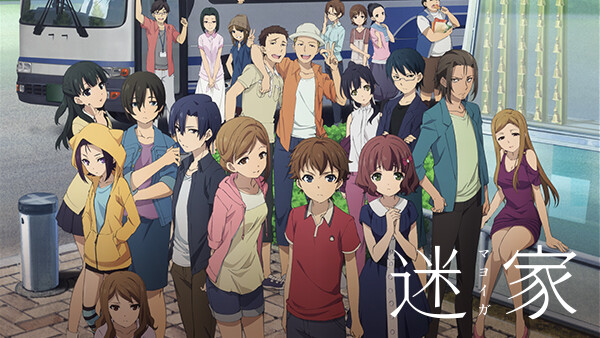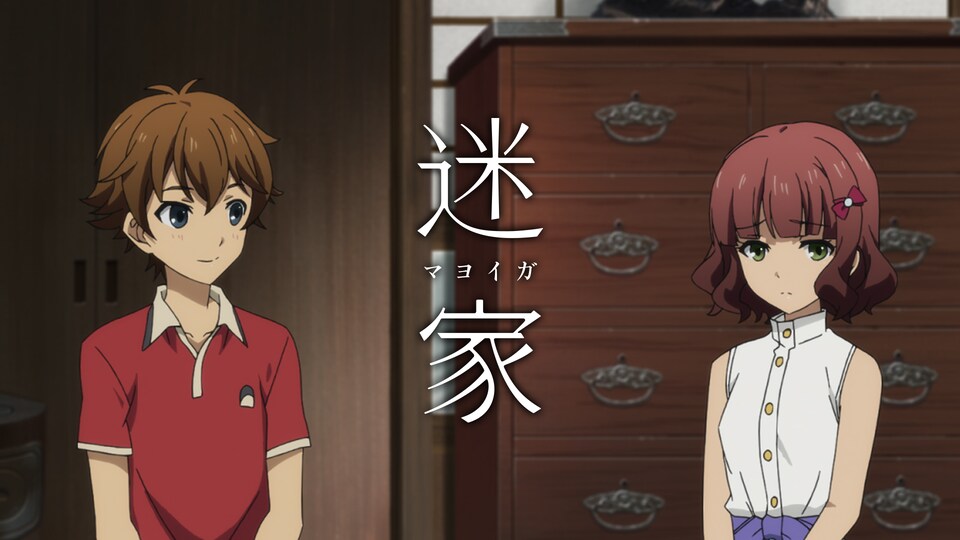Contents
Introduction

In the shadowy corners of anime narratives, few have sparked as much curiosity and debate as 'Mayoiga,' also known as 'The Lost Village.' This series, woven with threads of mystery and psychological drama, invites viewers into an eerie exploration of what happens when 30 individuals, each carrying their own hidden scars and stories, embark on a desperate quest to find a mythical village that promises to fulfill their deepest desires and erase their troubles.
At first glance, 'Mayoiga' presents itself as a classic adventure story, but it quickly transcends into a complex puzzle filled with suspense and unexpected twists. The characters, each drawn with their own peculiarities, are not just navigating through the dense, mist-covered paths to Mayoiga but are also traversing the labyrinth of their psyche, confronting their fears and illusions.
The narrative cleverly uses dialogue and interactions to peel back layers of each character, providing insights into their past and their motivations for joining this hazardous journey. The conversational tone, combined with the series' cliffhangers, ensures that viewers are constantly engaged, piecing together clues while theorizing possible outcomes.
Moreover, the setting of 'Mayoiga' plays a significant role in amplifying the show's thematic depth. The village, shrouded in fog and wrapped in folklore, symbolizes the elusive chase for utopia that each character pursues. Through its mysterious ambiance and the characters' vivid descriptions of their hopes, the anime challenges the viewer to ponder the realities of chasing idealistic dreams versus confronting actual fears.
In this exploration, 'Mayoiga' stands out not just for its intriguing plot but also for its ability to intertwine the real with the surreal, making it a compelling study of human nature and the often perilous journey of self-discovery. As we delve deeper into the series, it becomes clear that the real journey is not towards the mythical village but into the innermost chambers of the heart and mind, where the truest forms of ourselves reside, waiting to be confronted.
Plot Synopsis

'Mayoiga,' also known as 'The Lost Village,' presents a unique narrative that explores the psychological depths of human desires and fears through a suspense-filled plot. The story begins with 30 strangers, each with their own shadowed pasts and personal burdens, who meet online and decide to embark on a journey to locate Mayoiga, a mythical village said to be a utopia where one can start anew, free from the troubles of the modern world.
As the group travels deeper into the remote and dense wilderness, their bus journey becomes a catalyst for unfolding drama, with tensions escalating among the passengers. Each character's backstory is gradually revealed through conversations and flashbacks, adding layers to the plot and giving viewers a glimpse into the diverse motivations behind their quest. These narratives are artfully interwoven with the mysterious and eerie atmosphere of their destination, which they soon discover is not what it seems.
Upon arrival, the group encounters a series of inexplicable and frightening events that test their sanity and unity. The village, shrouded in mist and devoid of other inhabitants, becomes a haunting setting where the characters are forced to confront their darkest fears and illusions. Dialogue-driven scenes depict the characters' interactions, which oscillate between alliances and confrontations, mirroring the chaos within their minds and the disarray of their surroundings.
The plot thickens as the line between reality and hallucination blurs, challenging the viewers' perceptions and the characters' sense of reality. The series uses a conversational style to delve into themes of escapism, identity, and the human condition, making each episode a psychological thriller that keeps the audience guessing.
In 'Mayoiga,' the true suspense lies not in the hidden corners of the eerie village but in the complex web of human emotions and the mysterious pasts of the characters. This plot synopsis invites viewers into a labyrinthine tale of survival, self-discovery, and supernatural mysteries, where the greatest question is not what lies at the end of the journey, but what lies within each traveler.
Character Analysis

'Mayoiga,' or 'The Lost Village,' not only captivates with its enigmatic plot but also through its deeply complex characters, each adding a layer of intrigue to the story. This psychological drama introduces a large ensemble cast, where each character harbors their own secrets and motivations for joining the expedition to the mythical village believed to offer a new start.
One of the standout aspects of 'Mayoiga' is its ability to develop characters through dialogues that reveal their backstories and inner conflicts. For example, the protagonist, Mitsumune, is a young man escaping from the pressures of familial expectations. His journey to Mayoiga reflects his struggle with identity and his desire to define his own path, a theme resonant throughout the series.
The character of Masaki, on the other hand, embodies the mystery and suspense of the show. Her secretive nature and ambiguous background provide key plot twists and drive the group's dynamics. Her interactions often serve as a catalyst for conflict and resolution among the group, making her a central figure in understanding the psychological depth of the series.
Hayato, Mitsumune’s childhood friend, represents loyalty and protection, but his overprotectiveness leads to tension and dramatic confrontations. His character explores themes of friendship, control, and the fine line between care and obsession, enhancing the show's exploration of human psychology.
Lion, a seemingly aloof and observant girl, possesses the supposed ability to sense impending doom. Her character adds an element of supernatural to the storyline, intertwining with the show’s themes of fear and survival. Her interactions often provide philosophical insights and provoke critical reflections among the group, adding depth to the narrative.
Dialogue and personal revelations are expertly used in 'Mayoiga' to weave a rich tapestry of characters, each contributing to the eerie and mysterious atmosphere of the series. The conversational style of the script allows viewers to engage deeply with each character, making their discoveries and transformations feel personal and impactful.
In summary, 'Mayoiga' excels in character development, using its diverse cast to explore complex themes such as identity, redemption, and the human condition. The series challenges viewers to question what they would do in the face of their deepest fears and desires, making each character's journey a mirror to the audience’s own potential paths.
Themes and Symbolism
'Mayoiga,' also known as 'The Lost Village,' presents a rich tapestry of themes and symbols that delve into the human psyche and the quest for utopia. This series masterfully combines elements of mystery, psychological drama, and suspense, offering viewers a narrative filled with deeper meanings and reflections on social and personal issues.
At its core, 'Mayoiga' explores the theme of escape. Each character is driven by a desire to flee from their past and the burdens of their real-life problems, seeking solace in a legendary village that promises a fresh start and an escape from their troubles. This quest is symbolic of the universal human longing for redemption and the pursuit of an idealized life free from pain.
Another prominent theme in 'Mayoiga' is the confrontation with one's fears and inner demons. The mysterious setting of the village serves as a crucible for this confrontation, forcing characters to face their deepest fears manifested in various forms. This element of the show symbolizes the psychological journey of self-discovery and the often harrowing path to self-acceptance.
Identity and belonging are also critical themes depicted through the diverse cast of characters. Each individual’s backstory is a puzzle piece in understanding their motivations and how these influence their interactions with others. The village, as a liminal space between reality and fantasy, symbolizes the search for identity and a place where one truly belongs, reflecting the characters' internal struggles with societal expectations and self-identity.
The use of symbolism in 'Mayoiga' is evident in the eerie and often surreal environment of the village. The thick fog, dense forests, and abandoned settings are not just physical locations but are imbued with meaning, representing the unclear and often obscured paths the characters tread in both the physical and metaphorical sense. These elements enhance the show’s atmospheric tension and underscore the themes of mystery and the unknown.
Dialogue plays a crucial role in unfolding the themes of 'Mayoiga.' Conversations among the characters often reveal hidden fears, desires, and motivations, offering insights into their psychological states and the dynamics within the group. This conversational style makes the thematic exploration more engaging and relatable, allowing viewers to ponder their own responses to similar existential and psychological dilemmas.
In conclusion, 'Mayoiga' is a profound exploration of human desires, fears, and the innate quest for a "perfect world." Through its complex themes and rich symbolism, the series invites viewers to reflect on the nature of reality and illusion, the pain of the past, and the eternal human journey towards healing and finding one’s place in the world.
Cultural Impact and Fan Reception

'Mayoiga,' also known as 'The Lost Village,' resonates deeply within the anime community, not just for its intriguing plot but also for how it captures and portrays the nuances of human psychology and societal norms. This series has sparked considerable discussion among fans, reflecting on its cultural impact and the varied receptions it has garnered.
At its release, 'Mayoiga' quickly became a subject of fascination due to its unique blend of suspense and psychological elements. Viewers were drawn to its mysterious storyline, where a group of strangers embarks on a journey to find a mythical village, each with their own hopes of escaping their past. The series probes into themes like fear, survival, and the human condition, which strikes a chord with a broad audience, engaging them in discussions about the psychological depth of the characters and the surreal situations they encounter.
The reception of 'Mayoiga' has been polarized, with some praising its complex character development and eerie atmosphere, while others critique it for what they perceive as narrative disarray and unresolved story arcs. This division has fueled extensive debates in online forums and social media, demonstrating the show's ability to provoke thought and conversation about storytelling and character dynamics.
Culturally, 'Mayoiga' taps into the universal theme of searching for utopia—a place where all troubles are left behind, which is a prevalent motif in many cultures. The series amplifies this through its haunting visual and auditory presentation, enhancing the eerie and otherworldly feeling of the village. This has not only appealed to fans of psychological thrillers but also to those who appreciate the exploration of deeper existential themes.
'Mayoiga' has also impacted fan-driven content, inspiring a range of fan art, theories, and analyses that delve into the symbolic meanings of its setting and the psychological profiles of its vast cast. These creative engagements reflect the show's capacity to inspire and challenge its audience, encouraging a deeper dive into its thematic core.
In conclusion, 'Mayoiga' stands out in the anime landscape for its bold narrative and thematic richness, garnering a dedicated following that appreciates its psychological complexity and cultural resonance. The series continues to be a point of reference for discussions about the boundaries of anime storytelling and the portrayal of human desires and fears. Through its layered narrative and striking themes, 'Mayoiga' remains a significant cultural artifact in contemporary anime discussions.



